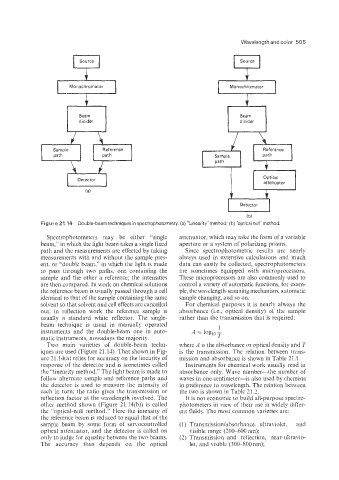Page 522 - Instrumentation Reference Book 3E
P. 522
Wavelength ana color 505
f Monochromator 1
ib)
Figure 2+l 1.41 Double-beam techniques in s~ec~~o~h~toin~tr~. ~Linear~ty~me~hod; "optical nuli" method.
(a)
(b)
Spectrophotometers may be either "single attenuator, which may take the form of a variable
beam," in which the light beam takes a single fixed aperture or a system of polarizing prisms.
path and the measurements are effected by taking Since spectrophotometric results are nearly
measurements with and without the sample pres- always used in extensive calculations and much.
ent, or "double beam," in which the light is made data can easily be collected, spec~roph~tonie~ers
with
to pass through two paths, one coiitaining the are sometimes equip~e~ inic~opr~cessors.
sample and the other a reference; the intensities These microprocessors are also commonly used to
are then compared. In work on chemical solutions control a variety of automatic functions, for exan-
the reference beam is usually passed through a cell ple, the wavelength-scanning mechanism, automatic
identical to that of the sample containing the same sample changing, and SO on.
solvent so that. solvent and cell effects are cancelled For chemical purposes it is nearly always the
out: in reflection work the reference sample is absorbance (i.e., optical density) of the sainple
that is required:
usually a standard white reflector. The single- rather than the ~rans~~ission
beam technique is usual in manually operated 1
instruments and the double-beam one in auto- A = log,,-
matic instruments, nowadays the majority. T
Two main varieties of double-beam techn- where A is the absorbance or optical density and T
iques are used (Figure 21.11). That shown in Fig- is the transmission. The relation between trans-
ure 21.14(a> relies for accuracy on the linearity of mission and absorbance is shown in Table 2 1.1.
response of the detector and is sometimes called Instrumen~s for chemical work usually read in
the "iinearity method." The light beam is made to absorbance only. Wave number---the number of
follow alternate sample and reference paths and waves in one centimeter-is also used by chemists
the detector is used to measure the intensity of in preference to wavelength. The relation between
each in turn; the rati'o gives the transmission or the two is shown in Table 21 2.
reflection factor at the wavelength involved. The It is not economic to build all-purpose spectro-
other method shown (Figure 21.14(b)) is called photometers in view of their use in widely differ-
the '~opt~ca~-~uI~ method." Here the intensity of ent fields. The most comin~n varieties are:
the reference beam is reduced to equal that of the
sampie beam by some form of servocontrolled (If Transinission/absorba3lce, ultraviolet, and
optical attenuator, and the detector is called on visible range (200-600 nm);
only to judge for equality between the two beams. (2) Transmission and reflection, near-ultravio-
The accuracy thus depends on the optical let, and visible (30&S00 nm):

